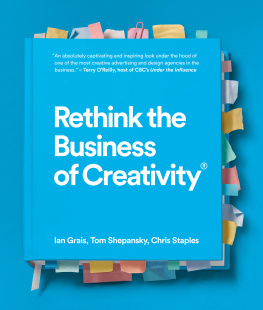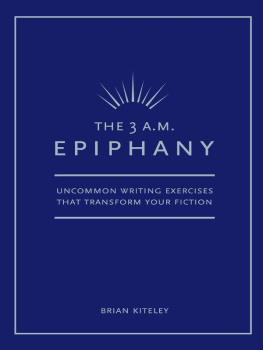The Business of reativity
Anthropology and Business: Crossing Boundaries, Innovating Praxis
SERIES EDITOR: Timothy de Waal Malefyt, Fordham School of Business
Both anthropology and business work at the forefront of culture and change. As anthropology brings its concerns with cultural organization and patterns of human behavior to multiple forms of business, a new dynamic of engagement is created. In addition to expanding interest in business as an object of study, anthropologists increasingly hold positions within corporations or work as independent consultants to businesses. In these roles, anthropologists are both redefining the discipline and innovating in industries around the world. These shifts are creating exciting cross-fertilizations and advances in both realms: challenging traditional categories of scholarship and practice, pushing methodological boundaries, and generating new theoretical entanglements. This series advances anthropologys multifaceted work in enterprise, from marketing, design, and technology to user experience research, work practice studies, finance, and many other realms.
First published 2014 by Left Coast Press, Inc.
Published 2016 by Routledge
2 Park Square, Milton Park, Abingdon, Oxon OX14 4RN
711 Third Avenue, New York, NY 10017, USA
Routledge is an imprint of the Taylor & Francis Group, an informa business
Copyright 2014 Brian Moeran
All rights reserved. No part of this book may be reprinted or reproduced or utilised in any form or by any electronic, mechanical, or other means, now known or hereafter invented, including photocopying and recording, or in any information storage or retrieval system, without permission in writing from the publishers.
Notice:
Product or corporate names may be trademarks or registered trademarks, and are used only for identification and explanation without intent to infringe.
Library of Congress Cataloging-in-Publication Data
Moeran, Brian, 1944
The business of creativity : toward an anthropology of worth / Brian Moeran.
pages cm(Anthropology and business ; 1)
Includes bibliographical references and index. ISBN 978-1-61132-911-7 (hardback) ISBN 978-1-61132-912-4 (paperback) ISBN 978-1-61132-913-1 (institutional ebook) ISBN 978-1-61132-914-8 (consumer eBook) 1. Creative abilityEconomic aspects. 2. Creative ability in business. I. Title.
HD53.M64 2013
302.35dc23
2013038212.
Cover design by Piper Wallis
Cover images by Brian Moeran
Text design by Margery Cantor
Earlier versions of parts of were previously published as A business anthropology approach to the study of values: evaluative practices in ceramic art in Culture and Organization 18(3):116 (2012); The organization of creativity in Japanese advertising production in Human Relations 62(7):96385 (2009); More than just a fashion magazine in Current Sociology 54(5):72544; and The Ursula faience dinnerware series by Royal Copenhagen in B. Moeran and B. T. Christensen (eds.), Exploring Creativity: Evaluative Practices in Innovation, Design, and the Arts (Cambridge University Press, 2013, pp. 121-45). In addition, some of the ideas developed here first appeared in the introduction to Exploring Creativity.
ISBN 978-1-61132-911-7 hardback
ISBN 978-1-61132-912-4 paperback
For the stone carver, musician, and artist who are my children
All patterns of creative activity are trivalent: they can enter the service of humour, discovery, or art.
Arthur Koestler, The Act of Creation
The conclusion of your syllogism, I said lightly, is fallacious, being based on licensed premises.
Flann OBrien, At Swim-Two-Birds
The aspects of things that are most important for us are hidden because of their simplicity and familiarity. (One is unable to notice something because it is always before our eyes.)
Ludwig Wittgenstein, Philosophical Investigations
I conceive of the art of painting as the science of juxtaposing colours in such a way that their actual appearance disappears and lets a poetic image emerge.
Ren Magritte
Divide a loaf by a knifewhats the answer to that?
Lewis Carroll, Through the Looking Glass, and What Alice Found There
This book would never have been written had it not been for the friendship and hospitality of Gwen and Per Dahlberg who, at a difficult time in my life, invited me for an open-ended stay with them on Lantau Island in Hong Kong. Tania Willis then kindly saved that friendship by allowing me to house-sit her dog, Dotty, while she spent several weeks over Christmas and the New Year with her family back in the United Kingdom. Dotty graciously accepted the intruder and, when not protecting him from a poisonous snake on the verandah, took him for long walks along the mountain and coastal paths of southern Lantau. This allowed him plenty of time to ruminate on the structure and contents of a book that has turned out somewhat differently from how it was first envisaged. But that is both the instruction and the joy (and, of course, the creativity) of writing.
That the book came to be envisaged in the first place was due to the encouragement of Wong Heung-Wah who, for many years now, has very sweetly insisted that what I have to say is important enough to be published in Chinese, and who has thus taken on the task of having an earlier version of this book translated into that language before it is published in English. Given the difficulties English and American publishers often experience with translation rights in non-European languages, this may well be the way forward for Western scholars in future. Better an audience of thousands than the customary few hundred.
Because parts of this book discuss pottery, and because an extremely important part of my life has developed through friendships with potters, I would like here to thank Sandy Brown for introducing me to the name of Bernard Leach, whom I then had the good fortune to meet back in May 1975, and Yasuda Takeshi for pointing me in the direction of Sarayama Onta as a potential field site for my doctoral research in anthropology.
Two others from the world of Japanese pottery whom I cannot, nor would ever wish to, overlook are Sakamoto Shigeki and Kajiwara Jir. Shigeki took me under his wing when I first went to do fieldwork in Sarayama Onta, opened up his household to me, and assigned himself the role of older brother (aniki) during the two years that I spent doing research there on the Japanese folk art movement. Jir did the same when I went over to Koishiwara to see how it compared with Onta. It is hard to understand why two men, whose lives wereand still areso different from my own, should have decided to befriend a visiting foreign anthropologist and help him with his research, but the fact that they did so has changed me irrevocably and contributed enormously (although they would never guess) to the particular worldview that I adopt in my scholarly work.













